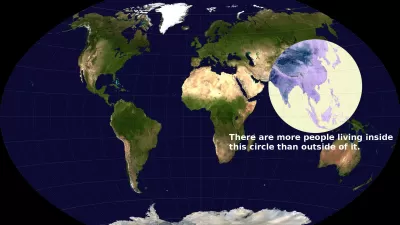A simple graphic posted to Reddit recently shows that more than half of the world's total population resides within a circle drawn over Asia. For Matthew Yglesias, it "underscores the fundamental truth of 21st-century economics."

As Caitlin Dewey explains in The Washington Post, the above graphic, which was posted by Reddit user valeriepieris, covers 19 Asian countries in which 3,637,830,357, or roughly 51.4 percent of the global population resides.
For Yglesias, the graphic illustrates Asia's emergence after two centuries of Western-led growth. "We had an approximately 200-year span in which an enormous amount of economic growth and geopolitical influence were located in Western Europe and its colonies in North America, but it's still the case that people mostly live in Asia."
"So now that all the countries inside the circle are politically independent and only a handful of them are still governed by totally insane ideologies, we should expect most of the action to happen where most of the people are," he continues. "That means most of the manufacturing, but also most of the innovation and most of the popular culture. Both the producers and consumers of everything live over there."
FULL STORY: Everybody Lives in Asia

Manufactured Crisis: Losing the Nation’s Largest Source of Unsubsidized Affordable Housing
Manufactured housing communities have long been an affordable housing option for millions of people living in the U.S., but that affordability is disappearing rapidly. How did we get here?

Americans May Be Stuck — But Why?
Americans are moving a lot less than they once did, and that is a problem. While Yoni Applebaum, in his highly-publicized article Stuck, gets the reasons badly wrong, it's still important to ask: why are we moving so much less than before?

Research Shows More Roads = More Driving
A national study shows, once again, that increasing road supply induces additional vehicle travel, particularly over the long run.

Judge Halts Enforcement of Anti-Homeless Laws in Grants Pass
The Oregon city will be barred from enforcing two ordinances that prosecute unhoused residents until it increases capacity and accessibility at designated camping sites.

Advancing Sustainability in Los Angeles County Schools
The Los Angeles County Office of Education’s Green Schools Symposium brings together educators, students, and experts to advance sustainability in schools through innovative design, climate resilience strategies, and collaborative learning.

Using Old Oil and Gas Wells for Green Energy Storage
Penn State researchers have found that repurposing abandoned oil and gas wells for geothermal-assisted compressed-air energy storage can boost efficiency, reduce environmental risks, and support clean energy and job transitions.
Urban Design for Planners 1: Software Tools
This six-course series explores essential urban design concepts using open source software and equips planners with the tools they need to participate fully in the urban design process.
Planning for Universal Design
Learn the tools for implementing Universal Design in planning regulations.
City of Moreno Valley
Institute for Housing and Urban Development Studies (IHS)
City of Grandview
Harvard GSD Executive Education
NYU Wagner Graduate School of Public Service
City of Cambridge, Maryland
Newport County Development Council: Connect Greater Newport





























